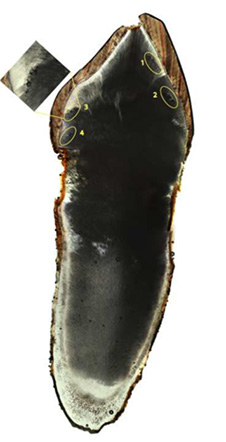Rickets ran rife in children following the Industrial Revolution, but University of Otago-led research has found factory work and polluted cities aren’t entirely to blame for the period’s vitamin D deficiencies.
In a Marsden funded study, just published in PLOS One, researchers from Otago, Durham University, University of Edinburgh, University of Brighton, and University of Queensland, sampled teeth from a cemetery site in industrial era England, looking for microscopic markers of nutritional disease.

Dr Annie Sohler-Snoddy.
Lead author Dr Annie Sohler-Snoddy, Research Fellow in Otago’s Department of Anatomy, says they uncovered some of the first clear evidence of seasonal vitamin D deficiency in an archaeological sample.
She says it has been known for many years that there was an increase in rickets, a childhood bone disease caused by vitamin D deficiency, in 18th and 19th Century Europe.
“It has been assumed that this was due to more people, including children, working long hours indoors, living in crowded housing and in smog-filled environments, all of which reduce the amount of sunlight that reaches a person’s skin, which is the main way humans make vitamin D.”
However, new bioarchaeological methods enabled the researchers to get a much clearer picture of how vitamin D deficiency affected the people living in industrial England, rather than looking at bone deformities alone.

Right permanent maxillary canine of a woman from Coach Lane, showing roughly annual episodes of interglobular dentin.
The study found markers associated with vitamin D deficiency in the interior part of 76 per cent of the teeth analysed. In many samples, these occurred regularly, in annual increments.
“This shows clear evidence of seasonal vitamin D deficiency in the teeth of people living in the north of England.
“This is exciting because it highlights that latitude and seasonal lack of sunlight was a major factor in the amount of vitamin D these people could make in their skin – it’s more complicated than the factors associated with the industrial revolution like working indoors more,” Dr Sohler-Snoddy explains.
Poor vitamin D status is associated with several negative health outcomes including increased risk for infectious diseases, cardiovascular disease, and cancers.
Vitamin D deficiency has been an ongoing problem in society and Dr Sohler-Snoddy believes it is important to study what happened in the past in order to inform modern approaches to the ailment.
“We tend to think of archaeological human remains as belonging to a different world, but our biology hasn’t changed in the last 200 years.
“Teeth provide a really important source of information for archaeologists as they form in a very precise chronology and, importantly, their tissues do not change over the lifespan. This means that they lock in a record of a person’s development and this stays with them until they die, or the tooth is lost.
“Understanding how vitamin D deficiency impacted past populations and why gives us an important deep-time perspective on the disease,” she says.
Publication details
Vitamin D status in post-medieval Northern England: insights from dental histology and enamel peptide analysis at Coach Lane, North Shields (AD 1711-5 1857)
Anne Marie E. Snoddy, Heidi Shaw, Sophie Newman, Justyna J. Miszkiewicz, Nicolas A. Stewart, Tina Jakob, Hallie Buckley, Anwen Caffell, Rebecca Gowland
PLOS One
For more information, contact:
Dr Anne Marie Sohler-Snoddy
Research Fellow
Biological Anthropology Research Group
Department of Anatomy
University of Otago
Email annie.sohler@otago.ac.nz
Ellie Rowley
Communications Adviser
University of Otago
Mob +64 21 278 8200
Email ellie.rowley@otago.ac.nz
